

S T R A T O L A U N C H - S Y S T E M S. Stratolaunch Systems. Stratolaunch Systems is a space transportation venture specializing in air launch to orbit, with its corporate headquarters located in Huntsville, Alabama.
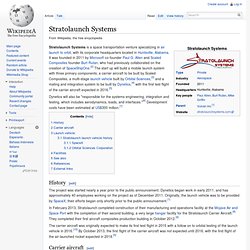
It was founded in 2011 by Microsoft co-founder Paul G. NASA Picks 7 Private Spaceships for Trips to Edge of Space. NASA has picked seven private spaceflight companies, each working to build a commercial spaceship, as its transportation of choice for launching experiments to the edge of space and back.
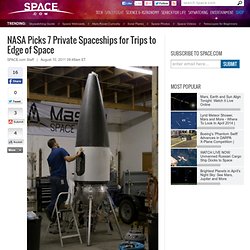
The space agency announced the selections Tuesday (Aug. 9), as part of the agency's Flight Opportunities Program. Whittinghillaerospace.com. XCOR Aerospace - Liquid fuel rocket engines, pumps composites an. XCOR Aerospace. XCOR Aerospace is an American private rocket engine and spaceflight development company based at the Mojave Spaceport in Mojave, California.[2] XCOR was formed by former members of the Rotary Rocket rocket engine development team in September, 1999.
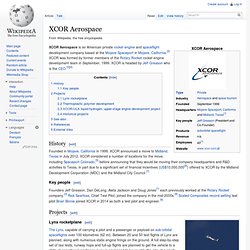
XCOR is headed by Jeff Greason who is the CEO.[3][4] History[edit] Founded in Mojave, California in 1999, XCOR announced a move to Midland, Texas in July 2012. UP Aerospace Inc. UP Aerospace. UP Aerospace, Inc. is a private spaceflight corporation based out of Denver, Colorado.
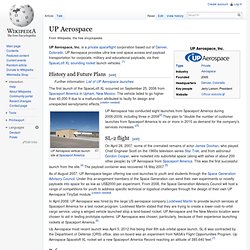
UP Aerospace provides ultra-low cost space access and payload transportation for corporate, military and educational payloads, via their SpaceLoft XL sounding rocket launch vehicles. [1] History and Future Plans[edit] The first launch of the SpaceLoft XL occurred on September 25, 2006 from Spaceport America in Upham, New Mexico. Masten Space Systems, Inc. Masten Space Systems. XA0.1E "Xoie" rocket on the competition-winning landing in the Lunar Lander Challenge at Mojave on Oct 30, 2009 XA0.1B "Xombie" lander tethered flight test on Sept 11, 2009 Masten Space Systems is an aerospace startup company in Mojave, California (formerly Santa Clara, California) that is developing a line of vertical takeoff, vertical landing (VTVL) spacecraft, initially for unmanned suborbital research flights and eventually intended to support unmanned orbital launches.

Overview[edit] Masten Space Systems is a Mojave, California based rocket company that is currently developing a line of reusable VTVL spacecraft, and related rocket propulsion hardware. X Prize Foundation. XPRIZE is a non-profit organization that designs and manages public competitions intended to encourage technological development that could benefit mankind.
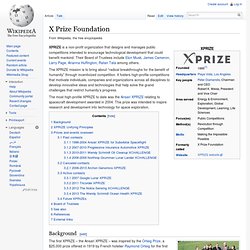
Their Board of Trustees include Elon Musk, James Cameron, Larry Page, Arianna Huffington, Ratan Tata among others. The XPRIZE mission is to bring about “radical breakthroughs for the benefit of humanity” through incentivized competition. It fosters high-profile competitions that motivate individuals, companies and organizations across all disciplines to develop innovative ideas and technologies that help solve the grand challenges that restrict humanity’s progress.
Orbital Sciences Corporation. Orbital Sciences Corporation (OSC, though commonly referred to as Orbital) is an American company specializing in the manufacturing and launch of satellites.

Its Launch Systems Group is heavily involved with missile defense launch systems. Orbital formerly owned ORBIMAGE (now GeoEye) and the Magellan line of GPS receivers, though they have now divested, the latter to Thales. Orbital's NYSE ticker symbol is ORB. It has its headquarters in the Dulles area of unincorporated Loudoun County, Virginia, United States.[2] Ansari X Prize. Mike Melville and Burt Rutan speak to the media after the first flight into Space The Ansari X Prize was a space competition in which the X Prize Foundation offered a US$10,000,000 prize for the first non-government organization to launch a reusable manned spacecraft into space twice within two weeks. It was modeled after early 20th-century aviation prizes, and aimed to spur development of low-cost spaceflight. Created in May 1996 and initially called just the "X Prize", it was renamed the "Ansari X Prize" on May 6, 2004 following a multi-million dollar donation from entrepreneurs Anousheh Ansari and Amir Ansari.
The prize was won on October 4, 2004, the 47th anniversary of the Sputnik 1 launch, by the Tier One project designed by Burt Rutan and financed by Microsoft co-founder Paul Allen, using the experimental spaceplane SpaceShipOne. $10 million was awarded to the winner, and more than $100 million was invested in new technologies in pursuit of the prize. Motivation[edit] Funding[edit] X Prize Cup. The Wirefly X Prize logo The X Prize Cup is a two-day Air & Space Expo which was the result of a partnership between the X Prize Foundation and the State of New Mexico that began in 2004 when the Ansari X-Prize was held.
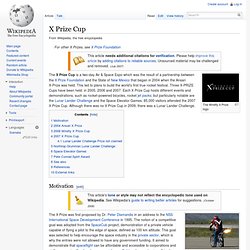
This led to plans to build the world's first true rocket festival. Three X-PRIZE Cups have been held: in 2005, 2006 and 2007. Google Lunar X Prize. Competition summary[edit] The Google Lunar X Prize offers a total of US$30 million in prizes to the first privately funded teams to land a robot on the Moon that successfully travels more than 500 meters (1,640 ft) and transmits back high definition images and video.

The first team to do so will claim the US$20 million Grand Prize; while the second team to accomplish the same tasks will earn a US$5 million Second Place Prize. Teams can also earn additional money by completing additional tasks beyond the baseline requirements required to win the Grand or Second Place Prize, such as traveling ten times the baseline requirements (greater than 5,000 meters (3 mi)), capturing images of the remains of Apollo program hardware or other man-made objects on the Moon, verifying from the lunar surface the recent detection of water ice on the Moon, or surviving a lunar night.
ExcaliburAlmaz. Excalibur Almaz. Excalibur Almaz is a private spaceflight company which plans to provide a variety of deep space crewed exploration missions, micro-gravity science, and payload delivery.

EA also aims to offer Low Earth Orbit cargo and crew delivery and return.[1] Design and flight safety reviews are planned for 2015.[2] According to a 2012 interview with Art Dula, the chairman of Excalibur Almaz, the Excalibur Almaz capsule is supposedly on a "very high level of technical readiness" and could be flown within 2 to 3 years. The main issue of the first manned flight of the Excalibur Almaz capsule is regulatory, according to Dula, as the VA capsule had already done 9 unmanned test flights during the Almaz program, all of which were successful.[3] The company has competed under NASA's Commercial Crew Development program but was not selected to receive funding under any phases of it.
History[edit] In 2009, Excalibur Almaz hoped to begin flights by 2012 with revenue flights starting as early as 2013.[5][6] Bristol Spaceplanes. Commercial crew: Boeing and Bigelow team up - Hyperbola.
Blue Origin - Careers. Blue Origin. Blue Origin New Shepard. The Blue Origin New Shepard reusable launch vehicle is a vertical-takeoff, vertical-landing (VTVL),[1] suborbital manned rocket that is being developed by Blue Origin, a company owned by Amazon.com founder and businessman Jeff Bezos, as a commercial system for suborbital space tourism. The New Shepard makes reference to the first United States astronaut in space, Alan Shepard. [citation needed] Space Future Journal - Virgin in a Three-Way Partnership.
As anyone who has studied business knows, corporations merge and divide like amoebae in a Petrie dish, often to the point where we cannot even tell who is merging with whom. So although we’d like to report that Virgin Galactic announced a partnership with Sierra Nevada Corporation (SNC) and Orbital Sciences Corporation, we need to lay out the decades-long complexities involving this partnership—not only for the readers’ benefits, but also so that we can understand it for ourselves... During 1990 and 1991 engineering studies were conducted on the NASA HL-20 Personnel Launch System lifting body by students and faculty of the North Carolina State University and North Carolina A&T University at the Langley Research Center.
Space Exploration Technologies Corp. - SpaceX. SpaceX collects contract to launch Thai satellite in 2013. SpaceX collects contract to launch Thai satellite in 2013 BY STEPHEN CLARKSPACEFLIGHT NOWPosted: June 13, 2011 TONBRIDGE, England -- SpaceX announced Monday it will launch a Thai television broadcasting satellite from Cape Canaveral in 2013, the second confirmed contract the company has secured this year for an international communications payload. File photo of a Falcon 9 rocket launch. Credit: Chris Thompson/SpaceX A Falcon 9 rocket will haul the Thaicom 6 communications satellite into orbit in the second quarter of 2013.
In a separate announcement Monday, officials said the spacecraft will be built by Orbital Sciences Corp. Hired private cargo ships booked to visit space station. Hired private cargo ships booked to visit space station BY STEPHEN CLARKSPACEFLIGHT NOWPosted: July 25, 2011 With the International Space Station stocked with food and clothing by the last space shuttle mission, SpaceX and Orbital Sciences are gearing up for test flights of their cargo freighters to the orbiting lab in December and February, government and industry officials said.
Artist's concept of a SpaceX Dragon spacecraft approaching the International Space Station. Can SpaceX Put A Man On Mars By 2031? SpaceX To Skeptics: We Can Beat China. What NASA Risks By Betting On Elon Musk’s SpaceX - Business in The Beltway - Money & Politics. SpaceX. Historic achievements by SpaceX, among others, include: the first privately funded, liquid-fueled rocket (Falcon 1) to reach orbit (28 September 2008); the first privately funded company to successfully launch (by Falcon 9), orbit and recover a spacecraft (Dragon) (9 December 2010); the first private company to send a spacecraft (Dragon) to the International Space Station[5] (25 May 2012); and the first private company to send a satellite into geosynchronous orbit (3 December 2013).
In 2006, NASA awarded the company a Commercial Orbital Transportation Services (COTS) contract to design and demonstrate a launch system to resupply cargo to the International Space Station (ISS). Dragon (spacecraft) Dragon is a partially reusable spacecraft developed by SpaceX, an American private space transportation company based in Hawthorne, California. Dragon is launched into space by the SpaceX Falcon 9 two-stage-to-orbit launch vehicle, and is capable of both manned and robotic operation. During its uncrewed maiden flight in December 2010, Dragon became the first commercially built and operated spacecraft to be recovered successfully from orbit.[3] On 25 May 2012, an uncrewed variant of Dragon became the first commercial spacecraft to successfully rendezvous with and be attached to the International Space Station (ISS).[11][12][13] SpaceX is contracted to deliver cargo to the ISS under NASA's Commercial Resupply Services program, and Dragon began regular cargo flights in October 2012.[14][15][16][17]
Falcon 9. Falcon 9 is a family of rocket-powered spaceflight launch vehicles designed and manufactured by SpaceX, headquartered in Hawthorne, California. The family consists of the Falcon 9 v1.0, Falcon 9 v1.1, and the Falcon 9-R.